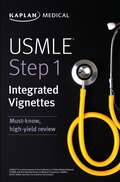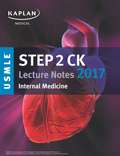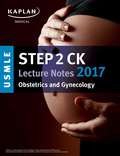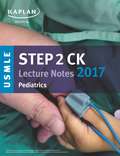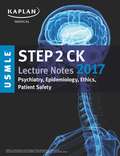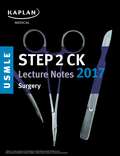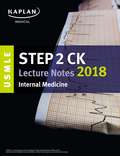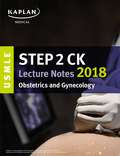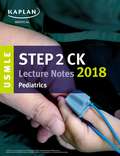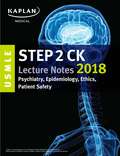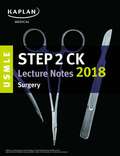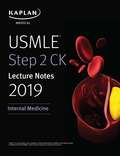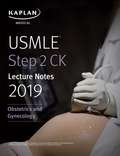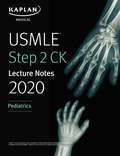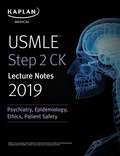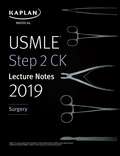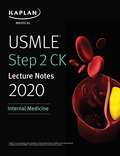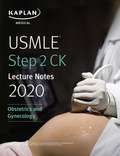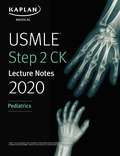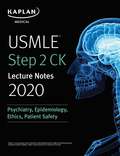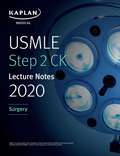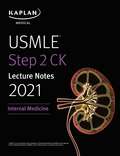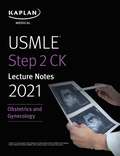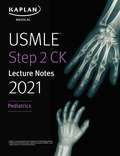- Table View
- List View
USMLE Step 1 Lecture Notes 2022: Physiology (USMLE Prep)
by Kaplan MedicalThe only official Kaplan Lecture Notes for USMLE Step 1 cover the comprehensive information you need to ace the exam and match into the residency of your choice. * Up-to-date: Updated annually by Kaplan&’s all-star faculty * Integrated: Packed with clinical correlations and bridges between disciplines * Learner-efficient: Organized in outline format with high-yield summary boxes * Trusted: Used by thousands of students each year to succeed on USMLE Step 1 Looking for more prep? Our USMLE Step 1 Lecture Notes 2022: 7-Book Set has this book, plus the rest of the 7-book series.
USMLE Step 1: Must-know, high-yield review (USMLE Prep)
by Kaplan MedicalKaplan Medical's USMLE Step 1 Integrated Vignettes provides must-know, high-yield facts for the Step 1 exam. A "question bank in book format," this portable tool will help you bridge the gap between preclinical coursework and Qbank usage. The focus is on integrated cases and differential diagnoses, along with practical clinical correlations.High-Yield ReviewChecklist of pathological processes within each organ systemClinical vignettes with high-yield explanations of conditionsTen representative diseases detailing morphologic features and differential diagnosesPhysiology and pharmacology correlations for every diseasePractice questions for self-assessment
USMLE Step 2 CK Lecture Notes 2017: Internal Medicine
by KaplanThe official Kaplan Lecture Notes for USMLE Step 2 CK cover the comprehensive information you need to ace the USMLE Step 2 and match into the residency of your choice.Up-to-date. Updated annually by Kaplan's all-star faculty.Highly illustrated. Includes color images and tables.Integrated. Packed with bridges between specialties and basic science.Learner-efficient. Organized in outline format with high-yield summary boxes.Trusted. Used by thousands of students each year to succeed on the USMLE Step 2.
USMLE Step 2 CK Lecture Notes 2017: Obstetrics/Gynecology
by KaplanThe official Kaplan Lecture Notes for USMLE Step 2 CK cover the comprehensive information you need to ace the USMLE Step 2 and match into the residency of your choice.Up-to-date. Updated annually by Kaplan's all-star faculty.Highly illustrated. Includes color images and tables.Integrated. Packed with bridges between specialties and basic science.Learner-efficient. Organized in outline format with high-yield summary boxes.Trusted. Used by thousands of students each year to succeed on the USMLE Step 2.
USMLE Step 2 CK Lecture Notes 2017: Pediatrics
by KaplanThe official Kaplan Lecture Notes for USMLE Step 2 CK cover the comprehensive information you need to ace the USMLE Step 2 and match into the residency of your choice.Up-to-date. Updated annually by Kaplan's all-star faculty.Highly illustrated. Includes color images and tables.Integrated. Packed with bridges between specialties and basic science.Learner-efficient. Organized in outline format with high-yield summary boxes.Trusted. Used by thousands of students each year to succeed on the USMLE Step 2.
USMLE Step 2 CK Lecture Notes 2017: Psychiatry, Epidemiology, Ethics, Patient Sa
by KaplanThe official Kaplan Lecture Notes for USMLE Step 2 CK cover the comprehensive information you need to ace the USMLE Step 2 and match into the residency of your choice.Up-to-date. Updated annually by Kaplan's all-star faculty.Highly illustrated. Includes color images and tables.Integrated. Packed with bridges between specialties and basic science.Learner-efficient. Organized in outline format with high-yield summary boxes.Trusted. Used by thousands of students each year to succeed on the USMLE Step 2.
USMLE Step 2 CK Lecture Notes 2017: Surgery
by KaplanThe official Kaplan Lecture Notes for USMLE Step 2 CK cover the comprehensive information you need to ace the USMLE Step 2 and match into the residency of your choice.Up-to-date. Updated annually by Kaplan's all-star faculty.Highly illustrated. Includes color images and tables.Integrated. Packed with bridges between specialties and basic science.Learner-efficient. Organized in outline format with high-yield summary boxes.Trusted. Used by thousands of students each year to succeed on the USMLE Step 2.
USMLE Step 2 CK Lecture Notes 2018: Internal Medicine
by Kaplan MedicalKaplan Medical's USMLE Step 2 CK Lecture Notes 2018: Internal Medicine offers in-depth review with a focus on high-yield topics – a comprehensive approach that will help you deepen your understanding while focusing your efforts where they'll count the most.Used by thousands of medical students each year to succeed on USMLE Step 2, Kaplan's official lecture notes are packed with full-color images and clear review.The Best ReviewOrganized in outline format with high-yield summary boxes for efficient studyBridges between specialties and basic science highlighted throughoutUpdated annually by Kaplan’s all-star expert facultyLooking for more prep? Our USMLE Step 2 CK Lecture Notes 2018: 5-Book Set has this book, plus the rest of the 5-book series.
USMLE Step 2 CK Lecture Notes 2018: Obstetrics/Gynecology
by Kaplan MedicalKaplan Medical's USMLE Step 2 CK Lecture Notes 2018: Obstetrics/Gynecology offers in-depth review with a focus on high-yield topics – a comprehensive approach that will help you deepen your understanding while focusing your efforts where they'll count the most.Used by thousands of medical students each year to succeed on USMLE Step 2, Kaplan's official lecture notes are packed with full-color images and clear review.The Best ReviewOrganized in outline format with high-yield summary boxes for efficient studyBridges between specialties and basic science highlighted throughoutUpdated annually by Kaplan’s all-star expert facultyLooking for more prep? Our USMLE Step 2 CK Lecture Notes 2018: 5-Book Set has this book, plus the rest of the 5-book series.
USMLE Step 2 CK Lecture Notes 2018: Pediatrics
by Kaplan MedicalKaplan Medical's USMLE Step 2 CK Lecture Notes 2018: Pediatrics offers in-depth review with a focus on high-yield topics – a comprehensive approach that will help you deepen your understanding while focusing your efforts where they'll count the most.Used by thousands of medical students each year to succeed on USMLE Step 2, Kaplan's official lecture notes are packed with full-color images and clear review.The Best ReviewOrganized in outline format with high-yield summary boxes for efficient studyBridges between specialties and basic science highlighted throughoutUpdated annually by Kaplan’s all-star expert facultyLooking for more prep? Our USMLE Step 2 CK Lecture Notes 2018: 5-Book Set has this book, plus the rest of the 5-book series.
USMLE Step 2 CK Lecture Notes 2018: Psychiatry, Epidemiology, Ethics, Patient Safety
by Kaplan MedicalKaplan Medical's USMLE Step 2 CK Lecture Notes 2018: Psychiatry, Epidemiology, Ethics, Patient Safety offers in-depth review with a focus on high-yield topics – a comprehensive approach that will help you deepen your understanding while focusing your efforts where they'll count the most.Used by thousands of medical students each year to succeed on USMLE Step 2, Kaplan's official lecture notes are packed with full-color images and clear review.The Best ReviewOrganized in outline format with high-yield summary boxes for efficient studyBridges between specialties and basic science highlighted throughoutUpdated annually by Kaplan’s all-star expert facultyLooking for more prep? Our USMLE Step 2 CK Lecture Notes 2018: 5-Book Set has this book, plus the rest of the 5-book series.
USMLE Step 2 CK Lecture Notes 2018: Surgery
by Kaplan MedicalKaplan Medical's USMLE Step 2 CK Lecture Notes 2018: Surgery offers in-depth review with a focus on high-yield topics – a comprehensive approach that will help you deepen your understanding while focusing your efforts where they'll count the most.Used by thousands of medical students each year to succeed on USMLE Step 2, Kaplan's official lecture notes are packed with full-color images and clear review.The Best ReviewOrganized in outline format with high-yield summary boxes for efficient studyBridges between specialties and basic science highlighted throughoutUpdated annually by Kaplan’s all-star expert facultyLooking for more prep? Our USMLE Step 2 CK Lecture Notes 2018: 5-Book Set has this book, plus the rest of the 5-book series.
USMLE Step 2 CK Lecture Notes 2019: Internal Medicine (Kaplan Test Prep)
by Kaplan MedicalThe only official Kaplan Lecture Notes for USMLE Step 2 CK cover the comprehensive information you need to ace the USMLE Step 2 and match into the residency of your choice.Up-to-date. Updated annually by Kaplan's all-star faculty.Highly illustrated. Includes color images and tables.Integrated. Packed with bridges between specialities and basic science.Learner-efficient. Organized in outline format with high-yield summary boxes.Trusted. Used by thousands of students each year to succeed on the USMLE Step 2.
USMLE Step 2 CK Lecture Notes 2019: Obstetrics/Gynecology (Kaplan Test Prep)
by Kaplan MedicalThe only official Kaplan Lecture Notes for USMLE Step 2 CK cover the comprehensive information you need to ace the USMLE Step 2 and match into the residency of your choice.Up-to-date. Updated annually by Kaplan's all-star faculty.Highly illustrated. Includes color images and tables.Integrated. Packed with bridges between specialities and basic science.Learner-efficient. Organized in outline format with high-yield summary boxes.Trusted. Used by thousands of students each year to succeed on the USMLE Step 2.
USMLE Step 2 CK Lecture Notes 2019: Pediatrics (Kaplan Test Prep)
by Kaplan MedicalThe only official Kaplan Lecture Notes for USMLE Step 2 CK cover the comprehensive information you need to ace the USMLE Step 2 and match into the residency of your choice.Up-to-date. Updated annually by Kaplan's all-star faculty.Highly illustrated. Includes color images and tables.Integrated. Packed with bridges between specialities and basic science.Learner-efficient. Organized in outline format with high-yield summary boxes.Trusted. Used by thousands of students each year to succeed on the USMLE Step 2.
USMLE Step 2 CK Lecture Notes 2019: Psychiatry, Epidemiology, Ethics, Patient Safety (Kaplan Test Prep)
by Kaplan MedicalThe only official Kaplan Lecture Notes for USMLE Step 2 CK cover the comprehensive information you need to ace the USMLE Step 2 and match into the residency of your choice.Up-to-date. Updated annually by Kaplan's all-star faculty.Highly illustrated. Includes color images and tables.Integrated. Packed with bridges between specialities and basic science.Learner-efficient. Organized in outline format with high-yield summary boxes.Trusted. Used by thousands of students each year to succeed on the USMLE Step 2.
USMLE Step 2 CK Lecture Notes 2019: Surgery (Kaplan Test Prep)
by Kaplan MedicalThe only official Kaplan Lecture Notes for USMLE Step 2 CK cover the comprehensive information you need to ace the USMLE Step 2 and match into the residency of your choice.Up-to-date. Updated annually by Kaplan's all-star faculty.Highly illustrated. Includes color images and tables.Integrated. Packed with bridges between specialities and basic science.Learner-efficient. Organized in outline format with high-yield summary boxes.Trusted. Used by thousands of students each year to succeed on the USMLE Step 2.
USMLE Step 2 CK Lecture Notes 2020: Internal Medicine (Kaplan Test Prep)
by Kaplan MedicalThe official Kaplan Lecture Notes for USMLE Step 2 CK cover the comprehensive information you need to ace the USMLE Step 2 and match into the residency of your choice. Up-to-date. Updated annually by Kaplan’s all-star faculty.Highly illustrated. Includes color images and tables.Integrated. Packed with bridges between specialities and basic science.Learner-efficient. Organized in outline format with high-yield summary boxes.Trusted. Used by thousands of students each year to succeed on the USMLE Step 2.
USMLE Step 2 CK Lecture Notes 2020: Obstetrics/Gynecology (Kaplan Test Prep)
by Kaplan MedicalThe official Kaplan Lecture Notes for USMLE Step 2 CK cover the comprehensive information you need to ace the USMLE Step 2 and match into the residency of your choice. Up-to-date. Updated annually by Kaplan’s all-star faculty. Highly illustrated. Includes color images and tables. Integrated. Packed with bridges between specialities and basic science. Learner-efficient. Organized in outline format with high-yield summary boxes. Trusted. Used by thousands of students each year to succeed on the USMLE Step 2.
USMLE Step 2 CK Lecture Notes 2020: Pediatrics (Kaplan Test Prep)
by Kaplan MedicalThe official Kaplan Lecture Notes for USMLE Step 2 CK cover the comprehensive information you need to ace the USMLE Step 2 and match into the residency of your choice. Up-to-date. Updated annually by Kaplan’s all-star faculty. Highly illustrated. Includes color images and tables. Integrated. Packed with bridges between specialities and basic science. Learner-efficient. Organized in outline format with high-yield summary boxes. Trusted. Used by thousands of students each year to succeed on the USMLE Step 2.
USMLE Step 2 CK Lecture Notes 2020: Psychiatry, Epidemiology, Ethics, Patient Safety (Kaplan Test Prep)
by Kaplan MedicalThe official Kaplan Lecture Notes for USMLE Step 2 CK cover the comprehensive information you need to ace the USMLE Step 2 and match into the residency of your choice. Up-to-date. Updated annually by Kaplan’s all-star faculty. Highly illustrated. Includes color images and tables. Integrated. Packed with bridges between specialities and basic science. Learner-efficient. Organized in outline format with high-yield summary boxes. Trusted. Used by thousands of students each year to succeed on the USMLE Step 2.
USMLE Step 2 CK Lecture Notes 2020: Surgery (Kaplan Test Prep)
by Kaplan MedicalThe official Kaplan Lecture Notes for USMLE Step 2 CK cover the comprehensive information you need to ace the USMLE Step 2 and match into the residency of your choice. Up-to-date. Updated annually by Kaplan’s all-star faculty. Highly illustrated. Includes color images and tables. Integrated. Packed with bridges between specialities and basic science. Learner-efficient. Organized in outline format with high-yield summary boxes. Trusted. Used by thousands of students each year to succeed on the USMLE Step 2.
USMLE Step 2 CK Lecture Notes 2021: Internal Medicine (Kaplan Test Prep)
by Kaplan MedicalThe official Kaplan Lecture Notes for USMLE Step 2 CK cover the comprehensive information you need to ace the USMLE Step 2 and match into the residency of your choice. Up-to-date. Updated annually by Kaplan&’s all-star faculty.Highly illustrated. Includes color images and tables.Integrated. Packed with bridges between specialities and basic science.Learner-efficient. Organized in outline format with high-yield summary boxes.Trusted. Used by thousands of students each year to succeed on the USMLE Step 2.
USMLE Step 2 CK Lecture Notes 2021: Obstetrics/Gynecology (Kaplan Test Prep)
by Kaplan MedicalThe official Kaplan Lecture Notes for USMLE Step 2 CK cover the comprehensive information you need to ace the USMLE Step 2 and match into the residency of your choice. Up-to-date. Updated annually by Kaplan&’s all-star faculty. Highly illustrated. Includes color images and tables. Integrated. Packed with bridges between specialities and basic science. Learner-efficient. Organized in outline format with high-yield summary boxes. Trusted. Used by thousands of students each year to succeed on the USMLE Step 2.
USMLE Step 2 CK Lecture Notes 2021: Pediatrics (Kaplan Test Prep)
by Kaplan MedicalThe official Kaplan Lecture Notes for USMLE Step 2 CK cover the comprehensive information you need to ace the USMLE Step 2 and match into the residency of your choice. Up-to-date. Updated annually by Kaplan&’s all-star faculty. Highly illustrated. Includes color images and tables. Integrated. Packed with bridges between specialities and basic science. Learner-efficient. Organized in outline format with high-yield summary boxes. Trusted. Used by thousands of students each year to succeed on the USMLE Step 2.

